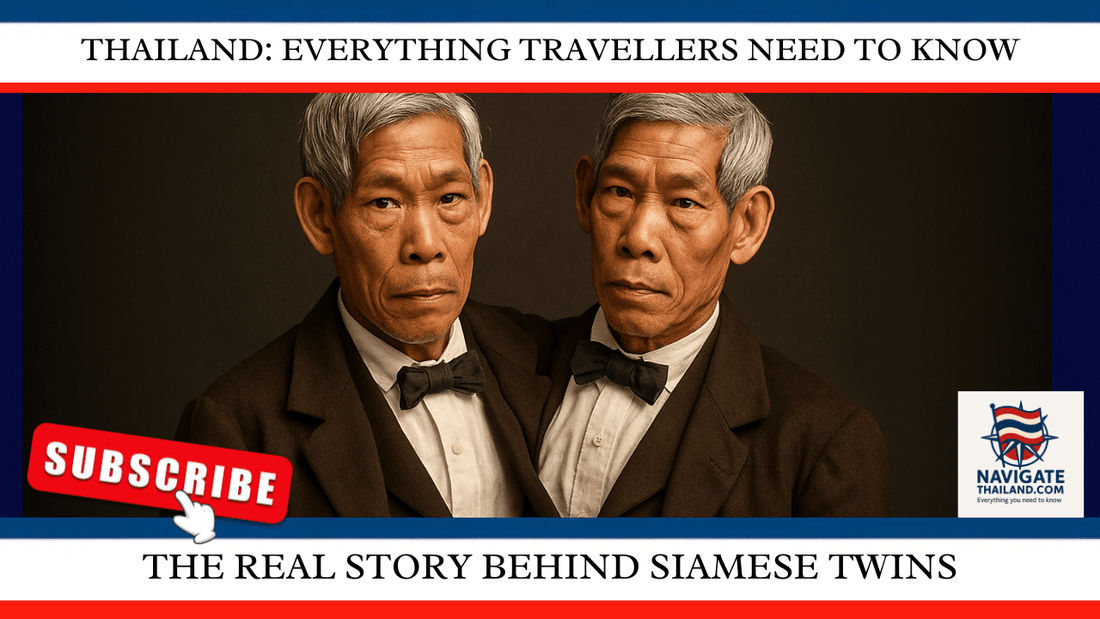
The Real Story Behind the Siamese Twins: Chang and Eng’s Thai Legacy
Share
If you’ve travelled to Thailand, you might have noticed the phrase “Siamese twins” pop up in historical exhibits or casual conversation. While the term is now outdated in medical circles, its origin is firmly rooted in Thai history—thanks to two remarkable brothers born in the early 19th century.
This is the story of Chang and Eng Bunker, conjoined twins born in Siam (now Thailand) who became international icons. Their lives not only inspired global fascination but also gave birth to a term still recognised around the world.
Who Were the Original Siamese Twins?
Born in 1811 in a fishing village near what is now Bangkok, Chang and Eng Bunker were connected at the chest by a narrow band of cartilage. Despite their physical connection, they lived active childhoods—helping their family’s fishing business and moving around independently.
Their lives changed dramatically in 1829 when they were discovered by British merchant Robert Hunter. Along with American promoter Abel Coffin, Hunter arranged for the twins to tour the United States and Europe. Marketed as a medical marvel, they were billed as the “Siamese Twins”—a reference to their country of origin.
Fun Fact: Although conjoined, Chang and Eng were strong and mobile. They could swim, run, and even play sports together.
Life in America: Fame, Family, and Independence
After years of public exhibition, Chang and Eng left the spotlight and settled in Mount Airy, North Carolina. There, they adopted the surname Bunker, bought land, and became naturalised American citizens. Perhaps most remarkably, they married two sisters and fathered a total of 21 children.
They lived in two separate houses, alternating between them every few days. While always physically connected, they developed distinct personalities—Chang being more serious and intense, while Eng was known for his calm and gentle nature.
They passed away in 1874, aged 62. Chang died first, likely from a stroke, and Eng followed just hours later—possibly from shock and the physical complications of their bond.
Why the Term “Siamese Twins”?
The global tours of Chang and Eng introduced Western audiences to the rare phenomenon of conjoined twins. Because they were born in Siam, they were forever linked to their homeland through the name used in promotions: “The Siamese Twins.”
The phrase stuck. Even today, “Siamese twins” remains a widely recognised—though medically outdated—term for conjoined twins. In modern contexts, the preferred term is simply conjoined twins.
Siam’s Role in Medical History
In the 19th century, conjoined twins were a rare and poorly understood medical condition. Chang and Eng sparked interest among physicians, biologists, and curious onlookers alike. They were examined by doctors in multiple countries, some of whom considered surgical separation—though it was deemed too risky given the technology of the time.
While their public displays were often exploitative, their case led to greater awareness of congenital anomalies and laid early groundwork for later advancements in paediatric surgery.
Fun Fact: The cartilage connecting them was just 15 cm wide, and each twin had their own fully functioning body—including separate organs.
Chang and Eng’s Legacy in Modern-Day Thailand
Today, the twins are remembered with pride in Thailand, especially in their birthplace, Samut Songkhram Province. A statue and museum exhibit honour their lives and contributions—not just as medical curiosities, but as global trailblazers.
In Thai culture, they are often seen as symbols of resilience, family values, and international recognition during a time when Siam was still relatively unknown to the Western world.
Their descendants still live in the United States today, many of whom continue to preserve their memory through family reunions, publications, and public storytelling.
Conjoined Twins in Modern Medicine
Thanks to significant advances in prenatal imaging and paediatric surgery, conjoined twins today can be diagnosed during pregnancy and assessed for potential separation. These procedures, while rare and highly complex, offer a much higher survival rate than in Chang and Eng’s era.
Surgical separation depends on where the twins are connected and whether they share critical organs. Even in cases where surgery isn’t possible, supportive care and adaptive strategies allow many conjoined twins to lead healthy lives.
Conclusion
Chang and Eng’s journey from a Thai fishing village to international fame is one of the most fascinating true stories in medical history. While the term “Siamese twins” has faded from modern usage, their legacy remains an important cultural and historical chapter.
As a traveller in Thailand, you may come across statues, museum exhibits, or local tales that honour the memory of these extraordinary brothers. Their story isn’t just about anatomy—it’s about family, identity, and the enduring connection between East and West.
Have you come across Chang and Eng’s story on your travels in Thailand? Share your thoughts in the comments, and don’t forget to pass this blog along to others. You can also subscribe to our YouTube channel, where we’re turning this blog into a full video to dive even deeper into the lives of the original Siamese twins.
References:
• National Geographic – The Story of Chang and Eng Bunker
• Smithsonian Magazine – The World’s First Conjoined Twins
• History Channel – The Lives of Chang and Eng Bunker
Read more of our Thailand blog series:
Thai Food Guide:Traditional Recipes and Street Eats
Everything Travellers Need to know
Thailand travel ebooks and language guides
Thailand Travel Apparel & Souvenir Gifts
Subscribe to our YouTube channel Navigate Thailand to see our most popular Thailand travel blogs turned into videos:
Navigate Thailand YouTube channel


















































































































































